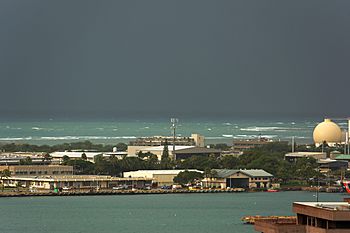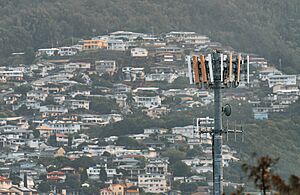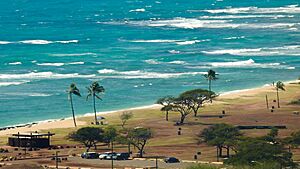Sand Island (Hawaii) facts for kids

Looking over Sand Island
|
|
Quick facts for kids Geography |
|
|---|---|
| Coordinates | 21°18′25″N 157°52′45″W / 21.30694°N 157.87917°W |
| Administration | |
Sand Island is a small island located in Honolulu, Hawaii, United States. It sits right at the entrance to Honolulu Harbor. This island has a long and interesting past, from being a place where ships were checked for sickness to a site used during wartime.
Contents
Island History: A Look Back
In the 1800s, Sand Island was known as Quarantine Island. It was used to keep ships and their passengers separate if they were thought to have contagious diseases. This helped stop illnesses from spreading to the main city.
Sand Island During World War II
During World War II, Sand Island became an internment camp. This camp held Japanese Americans and people from Germany, Italy, and other Axis countries who lived in Hawaii. The camp opened in December 1941, shortly after the attack on Pearl Harbor. Many people were arrested, sometimes without clear reasons, and sent to this camp.
Over 600 Hawaiian residents, including many U.S. citizens, were held at Sand Island. The camp closed in March 1943. Most of the people held there were moved to other camps on the mainland. The remaining 149 people went to a new camp called Honouliuli Internment Camp.
Changes Over Time
In the 1970s, more than 100 native Hawaiians who did not have homes cleaned up the island. They built homes and lived there. However, in the early 1980s, the State of Hawaii took back about 180 acres of the island. This land was planned for factories and fun places for people to visit. The people living there were asked to leave without being paid for their homes or efforts.
Today, Sand Island has a state park where people can relax and play. It also has a U.S. Coast Guard base, a water treatment plant, and various industrial buildings.
Community Efforts on Sand Island
Sand Island has faced challenges with people not having homes. Residents and city leaders have discussed creating a special camp to help. This has been a topic of discussion for several years. The city is working on plans to manage public behaviors and hopes to get approval from the city council soon.
Geography and Climate
Sand Island covers about 203.78 hectares (or about 503.55 acres) of land. In the year 2000, about 184 people lived on the island.
Island Weather
Sand Island has pleasant weather all year round. The temperatures do not change much between seasons. However, there is a clear difference between the wet and dry times of the year.
In the summer, high temperatures are usually between 87 to 91°F (31 to 33°C). In the winter, highs are a bit cooler, ranging from 77 to 85°F (25 to 29°C). Not much rain falls throughout the year, especially in the summer. The island enjoys about 3,100 hours of sunshine every year.



